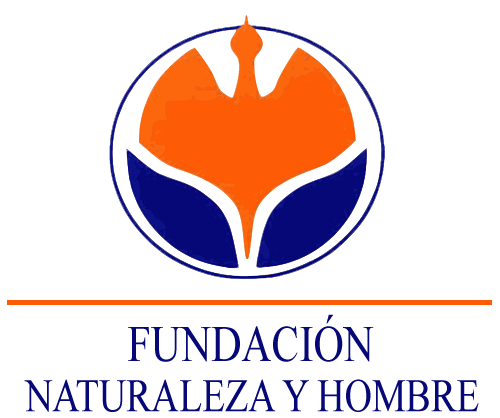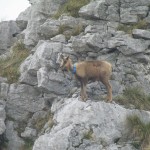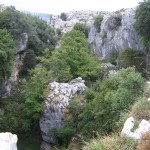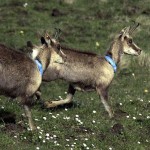The Chamois (Rupicapra pyrenaica) is a bovid that looks like a goat. Both, males and females have little and curved horns in a black shade. His head and throat have a light color, while in the eye area it has a darker stain that seems to a mask.
The body maintains a uniform color, only altered by a line running along its back. The characteristics of the chamois coat vary depending on the seasons. In the summer season it is short and reddish-gray, whereas in the wintertime it becomes thicker and longer, with an almost black color on the sides and on both sides of the neck.
Sexual dimorphism is noticeable especially in the Cantabrian chamois (Rupicapra pyrenaica parva), subspecies which has been reintroduced in the Eastern Mountain of Cantabria. Males are larger than females, and its horns reach a larger size and thickness. For reference, the adults’ chamois – regardless of sex – usually reach over a meter in length and 70 cm. tall at the withers; they weigh between 25 and 35 kg.
Characteristics
Since 1985, they have considered the existence of two species: Rupicapra pyrenaica, that covers the Cantabrian chamois, the Pyrenees and the Apennines chamois; and Rupicapra rupicapra, typically of the Alps. Both are divided in turn into different subspecies.
The Cantabrian chamois (Rupicapra pyrenaica parva) is smaller than their Pyrenean counterparts, a difference that is also seen in the length of their horns. His coat is reddish in the summertime and a lighter gray in wintertime. It has a reddish-brown tail against the Pyrenean chamois that have a black hue.
Behavior
Chamois behavior is typical of hoofed animals of the mountain area. The thickness of her winter coat, her feet and legs (with an interdigital membrane that increases the bearing surface on the snow) and the ability to process woody plants as food, show a high degree of adaptation to the environment.
Its activity is essentially daytime, even in midsummer. Males remain alone or in groups most of the year. Following this model, females form groups with young hatchlings and young last year. This intersexual separation breaks during the rutting seasons that focuses on the months of October and November.
After mating, the gestation lasts for six months, at the end of which a baby is born, exceptionally two. The new chamois reaches maturity at about 15 months and it gets the independence of their origin group at 2 years. His life expectancy, if he stays in liberty, will be about 17 years.
The groups of specimens prefer areas of Medium to High Mountain. When the winter is coming, they descended down to the limits of montane forests or they occupy their upper parts, sharing habitat with roe deer (Capreolus capreolus). They like to live in very rough terrain, as it is in these areas where their morphological characteristics allow them to circumvent the threat of predators.
With respect to feeding, the chamois of East Mountain Cantabria feed mainly grasses and herbaceous plants. Especially, they feel predilection for meadow fescue (Festuca paniculata), the carex, clover (Trifolium pratense) during the summer season, hollies (Ilex aquifolium), blueberries (Vaccinium myrtillus), brambles (Rubus ulmifolius) and juniper (Juniperus sp.) in the wintertime.
Distribution
Generically chamois populates the mountains of central and southern Europe and the Middle East, especially Turkey and the Caucasus region. In the early twentieth century, the species were introduced in the highlands of New Zealand.
Cantabrian chamois population is about 16.000 specimens in the mountains from which it takes its name, 5.500 of them registered in “Picos de Europa”. This figure must include 100 chamois (September 2011) that after more than 150 years of absence, they walk the East Mountain of Cantabria in the freedom, thanks to reintroduction plan launched by Nature and Man Foundation.
Considering the optimal density of the species in the mountains of average altitude – between 8 and 10 per square kilometer – the Massif Ason could sustain a figure close to 600 chamois.





